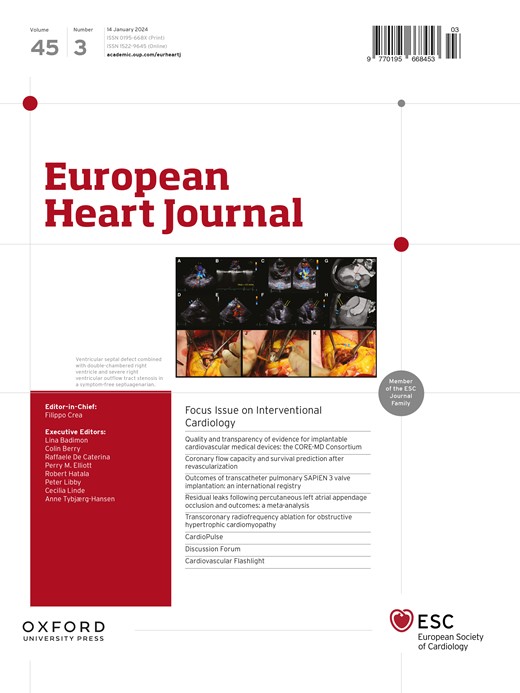LDL-cholesterol in newborns and children with genetically verified familial hypercholesterolaemia: implications for cholesterol-based screening.
IF 35.6
1区 医学
Q1 CARDIAC & CARDIOVASCULAR SYSTEMS
引用次数: 0
Abstract
BACKGROUND AND AIMS Cholesterol screening in children, with subsequent genetic testing of top percentile, has been suggested as an efficient universal screening approach in familial hypercholesterolaemia (FH). The potential cholesterol-based screening efficacy was investigated in a national genetically based screening programme. METHODS Data were from the Norwegian national family cascade screening programme in FH children from 1998 to 2023. Cholesterol levels [umbilical cord in newborns (n = 113) and venous blood in children 1-12 years old (n = 1346)] in variant positive and variant negative children were compared. RESULTS LDL cholesterol (LDL-C) was higher in FH newborns vs non-FH newborns [1.22 (.48) vs .68 (.32) mmol/L, P < .001], but overlapped widely. Cut-off levels corresponding to the 95th and 85th percentile would only identify 55.7% and 75.4% of newborns with FH, respectively. Screening efficacy in newborns did not differ in subgroups: boys and girls, null and non-null variants, variant gene, and neither for total cholesterol nor for non-HDL cholesterol. In all other age groups (from 1 to 12 years), LDL-C discriminated highly between mutation FH and non-FH children. Cut-off levels corresponding to 95th and 85th percentile of LDL-C would identify 88.4% and 94.1% of 1-12-year-old children with FH, respectively. CONCLUSIONS Previous studies investigating lipid or genetic screening approaches for FH have limitations of only performing genetic testing in children with high LDL-C levels. The present study is the first to show the true LDL-C overlap in children with FH vs non-FH by utilizing unique data from a national family cascade screening programme. Cholesterol-based screening approaches for FH only seem feasible from 1 year of age onward.新生儿和遗传证实的家族性高胆固醇血症儿童的低密度脂蛋白胆固醇:基于胆固醇筛查的意义
背景和目的:儿童胆固醇筛查,随后进行最高百分位数的基因检测,已被认为是家族性高胆固醇血症(FH)的一种有效的普遍筛查方法。在一项全国性的基于基因的筛查项目中,研究了潜在的基于胆固醇的筛查效果。方法数据来自1998年至2023年挪威国家FH儿童家庭级联筛查项目。比较变异阳性和变异阴性儿童的胆固醇水平[新生儿脐带(113例)和1 ~ 12岁儿童静脉血(1346例)]。结果FH新生儿的低密度脂蛋白胆固醇(LDL-C)高于非FH新生儿[1.22(1.48)比;68 (.32) mmol/L, P < .001],但重叠广泛。对应于第95和85百分位的截止水平分别只能识别出55.7%和75.4%的FH新生儿。新生儿的筛查效果在亚组中没有差异:男孩和女孩,无效和非无效变异,变异基因,总胆固醇和非高密度脂蛋白胆固醇均无差异。在所有其他年龄组(1至12岁)中,LDL-C在突变FH和非FH儿童之间具有高度区别。LDL-C的第95百分位和第85百分位对应的截止水平将分别确定88.4%和94.1%的1-12岁儿童患有FH。结论以往研究FH的脂质或遗传筛查方法存在局限性,仅对高LDL-C水平儿童进行基因检测。本研究首次利用来自全国家庭级联筛查项目的独特数据,显示了FH患儿与非FH患儿的LDL-C重叠。以胆固醇为基础的FH筛查方法似乎只有在1岁以后才可行。
本文章由计算机程序翻译,如有差异,请以英文原文为准。
求助全文
约1分钟内获得全文
求助全文
来源期刊

European Heart Journal
医学-心血管系统
CiteScore
39.30
自引率
6.90%
发文量
3942
审稿时长
1 months
期刊介绍:
The European Heart Journal is a renowned international journal that focuses on cardiovascular medicine. It is published weekly and is the official journal of the European Society of Cardiology. This peer-reviewed journal is committed to publishing high-quality clinical and scientific material pertaining to all aspects of cardiovascular medicine. It covers a diverse range of topics including research findings, technical evaluations, and reviews. Moreover, the journal serves as a platform for the exchange of information and discussions on various aspects of cardiovascular medicine, including educational matters.
In addition to original papers on cardiovascular medicine and surgery, the European Heart Journal also presents reviews, clinical perspectives, ESC Guidelines, and editorial articles that highlight recent advancements in cardiology. Additionally, the journal actively encourages readers to share their thoughts and opinions through correspondence.
 求助内容:
求助内容: 应助结果提醒方式:
应助结果提醒方式:


